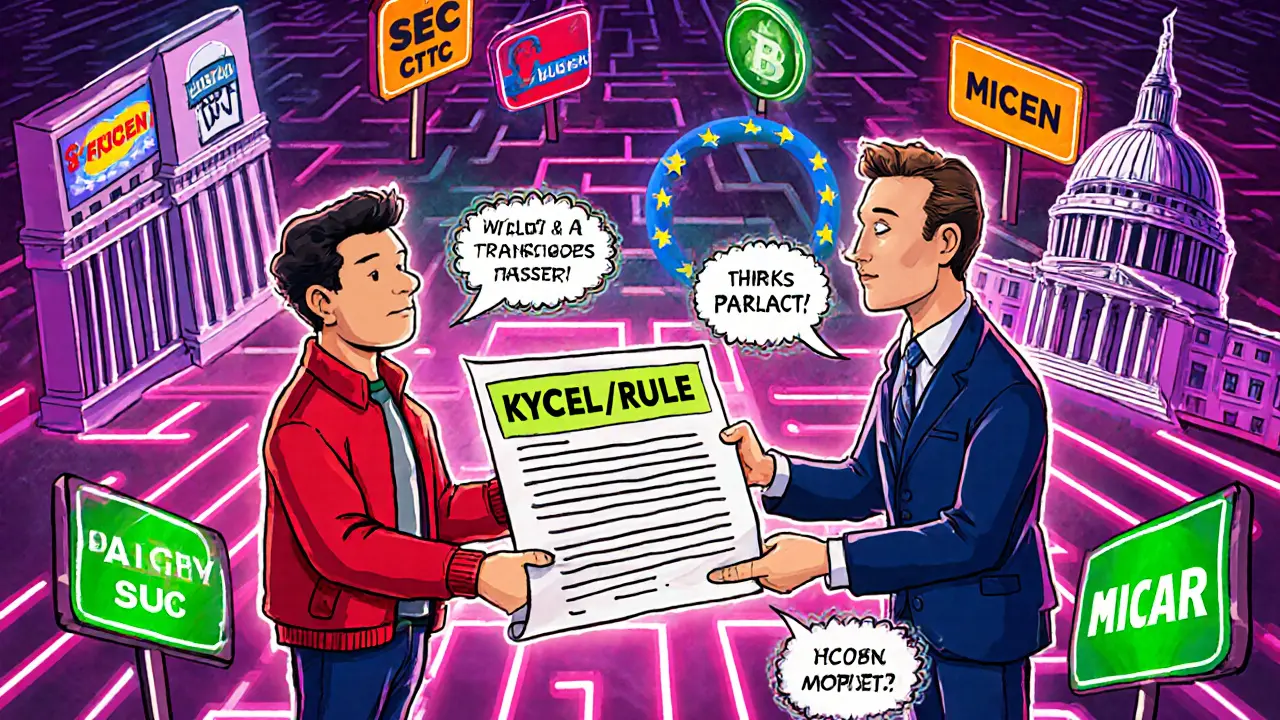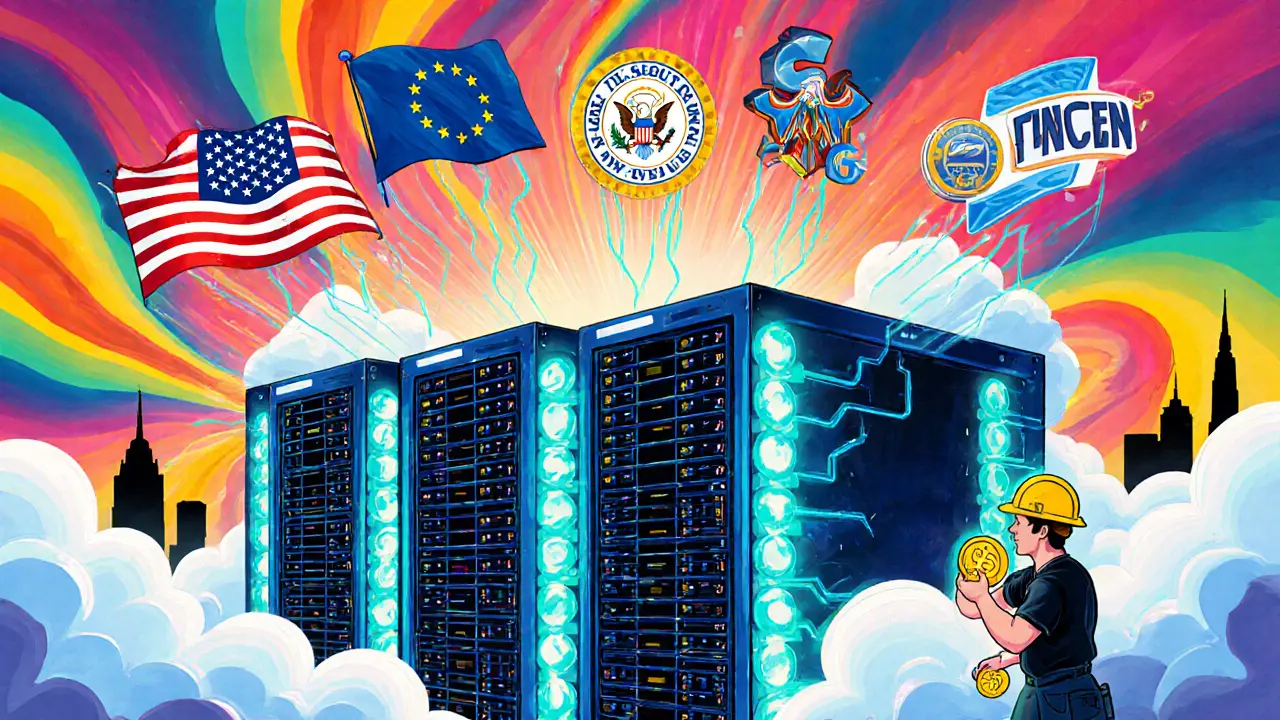Crypto Mining Compliance Calculator
Regulatory Requirements Calculator
Determine your compliance obligations based on your mining operation details.
When you hear the term Crypto Mining is the process of using computer power to validate transactions and secure public blockchain networks, rewarding participants with new digital tokens, the first thing that comes to mind is usually hardware, electricity, and profit. But in 2025 the legal picture has become just as critical as the technical one. New federal bills, fresh SEC guidance, and the EU’s MiCAR regime mean miners must juggle compliance, tax, and sustainability rules before they even plug in a GPU. This guide walks you through the biggest legal hurdles, shows where the United States and Europe differ, and gives you a checklist you can start using today.
US Regulatory Framework: Who’s Watching?
The United States now layers three major agencies over crypto mining. FinCEN the Financial Crimes Enforcement Network, enforces the Bank Secrecy Act’s AML and CFT rules for virtual‑asset service providers treats mining operations as financial institutions, so you’ll need a BSA registration if you earn more than $10,000 in a year. The SEC the Securities and Exchange Commission, oversees securities law compliance for digital assets announced in March 2025 that Proof‑of‑Work mining does not fall under securities laws - a huge relief for Bitcoin, Dogecoin, and Litecoin miners. Finally, the CFTC the Commodity Futures Trading Commission, regulates derivatives and commodity futures linked to crypto still watches any mining‑related futures contracts. Together these agencies create a patchwork of AML/KYC obligations, reporting thresholds, and record‑keeping duties that vary by state.
EU Landscape: MiCAR and the Emerging Taxonomy
Across the Atlantic, the European Union rolled out the Markets in Crypto‑Assets Regulation (MiCAR) in December 2024. MiCAR a comprehensive EU framework that requires licensing for firms issuing electronic money tokens, asset‑referenced tokens and providing crypto‑asset services forces miners that sell directly to EU consumers to obtain a crypto‑asset service provider license or partner with a licensed bank. The EU is also moving crypto mining into its taxonomy regulation, meaning banks that fund mining projects must evaluate the energy intensity against EU sustainability criteria. For operators, this translates into two parallel tracks: meet the AML/KYC rules (the EU mirrors the US’s $3,000 Travel Rule threshold) and prove that your energy mix aligns with the taxonomy’s green‑energy definition.
Core Compliance Pillars: AML, KYC, and the Travel Rule
Whether you’re in New York or Berlin, the first line of defence is anti‑money‑laundering compliance. The crypto mining regulations now demand you collect, store, and transmit personally identifiable information for any reward payout or internal transfer above $3,000. That includes the name, address, wallet address, transaction hash, and the originating financial institution. FinCEN calls this the Travel Rule, and the FATF expects the same from EU players under MiCAR. Failure to log these details can trigger civil penalties of up to $250,000 per violation in the US, and hefty fines from national regulators in Europe.

Proof‑of‑Work vs. Proof‑of‑Stake: Different Legal Treatment
The SEC’s March 2025 clarification singled out Proof‑of‑Work (PoW) as “protocol mining” that does not create securities. That means Bitcoin, Litecoin, and other PoW chains stay out of the SEC’s securities scope. By contrast, Proof‑of‑Stake (PoS) systems-where validators lock up tokens to earn rewards-often involve ownership stakes that can be deemed securities. If you plan to transition a mining operation to a PoS model, expect a whole new set of filing requirements, possibly including registration as a broker‑dealer or an investment adviser under the Investment Advisers Act.
The GENIUS Act: What It Means for Miners
During “Crypto Week” in March 2025, Congress passed the GENIUS Act, the first comprehensive federal crypto statute. The law clarifies that crypto‑related businesses, including mining pools, must register as Money Service Businesses (MSBs) if they exceed the $10,000 transaction threshold, but it also gives the Treasury Secretary authority to create a uniform licensing regime for mining operations that serve multiple states. In practice, the act smooths out the state‑by‑state compliance maze: instead of filing separate MSB registrations in Texas, Wyoming, and New York, you can apply for a single federal license once the Treasury rolls out the rules (expected Q4 2025).
Practical Checklist for Mining Operators
- Register as an MSB with FinCEN if annual gross receipts > $10,000.
- Implement a KYC/Travel Rule solution that captures all required PII for payouts ≥ $3,000.
- Document your energy source; prepare a sustainability report if you serve EU‑based customers.
- Track whether your consensus mechanism is PoW or PoS and adjust legal counsel accordingly.
- Monitor the Treasury’s forthcoming licensing framework under the GENIUS Act.
- Set up a regular audit schedule (quarterly) to verify AML logs and filing accuracy.

Comparing US and EU Mining Requirements
| Aspect | United States | European Union |
|---|---|---|
| Primary regulator | FinCEN (BSA), SEC (securities), CFTC (commodities) | MiCAR under ESMA, national AML authorities |
| AML/KYC threshold | $3,000 (Travel Rule) | €2,500‑€3,000 (equivalent) |
| Licensing requirement | MSB registration; GENIUS Act pending federal license | Crypto‑asset service provider license or partnership with a licensed bank |
| Proof‑of‑Work status | Not a security (SEC 2025 statement) | Not a security under MiCAR, but must meet AML rules |
| ESG reporting | Voluntary, but increasing scrutiny from regulators | Mandatory if classified under EU taxonomy; energy source disclosure required |
Staying Ahead: Monitoring and Legal Updates
Regulation moves faster than hardware upgrades. Set up alerts on FinCEN’s notice board, the SEC’s rulemaking portal, and the European Commission’s MiCAR updates. Join industry groups like the Crypto Mining Association (CMA) - they often publish “ compliance briefs” that translate dense legalese into actionable steps. Finally, schedule a semi‑annual legal review with counsel who specialize in digital assets; a small compliance lapse can cost you far more than a new ASIC rig.
Conclusion: Compliance Is the New Mining Revenue Stream
In 2025 the biggest profit driver for a mining operation isn’t the hash rate; it’s the ability to stay on the right side of the law. By registering with the proper authorities, implementing robust Travel Rule tools, and watching the evolving GENIUS Act framework, you can focus on what you do best - mining blocks. Keep an eye on the EU’s taxonomy rules if you serve European markets, and always be ready to adjust when PoS tokens start to dominate the space. With a proactive compliance plan, you’ll protect your business, attract institutional partners, and future‑proof your operation against the next wave of regulation.
Do I need a license to mine Bitcoin in the US?
If your total annual mining revenue exceeds $10,000, FinCEN requires you to register as a Money Service Business under the BSA. The GENIUS Act will later allow a single federal license for multi‑state operators.
What is the Travel Rule and how does it affect miners?
The Travel Rule obliges you to collect and transmit PII for any transaction of $3,000 or more, including the sender’s and receiver’s name, address, wallet address, and transaction hash. Non‑compliance can lead to civil penalties.
Is Proof‑of‑Work mining considered a securities activity?
No. In March 2025 the SEC issued a definitive statement that PoW mining does not create securities, clearing the path for Bitcoin, Litecoin and similar networks.
How does MiCAR impact crypto miners serving EU customers?
MiCAR requires a crypto‑asset service provider license or a partnership with a licensed bank to offer mining rewards to EU residents. You also need to disclose your electricity source under the EU taxonomy.
What are the biggest ESG concerns for crypto mining?
Energy consumption and carbon emissions are the primary concerns. The EU taxonomy now classifies high‑intensity mining as non‑sustainable, so operators must prove the use of renewable energy to attract institutional capital.

Write a comment